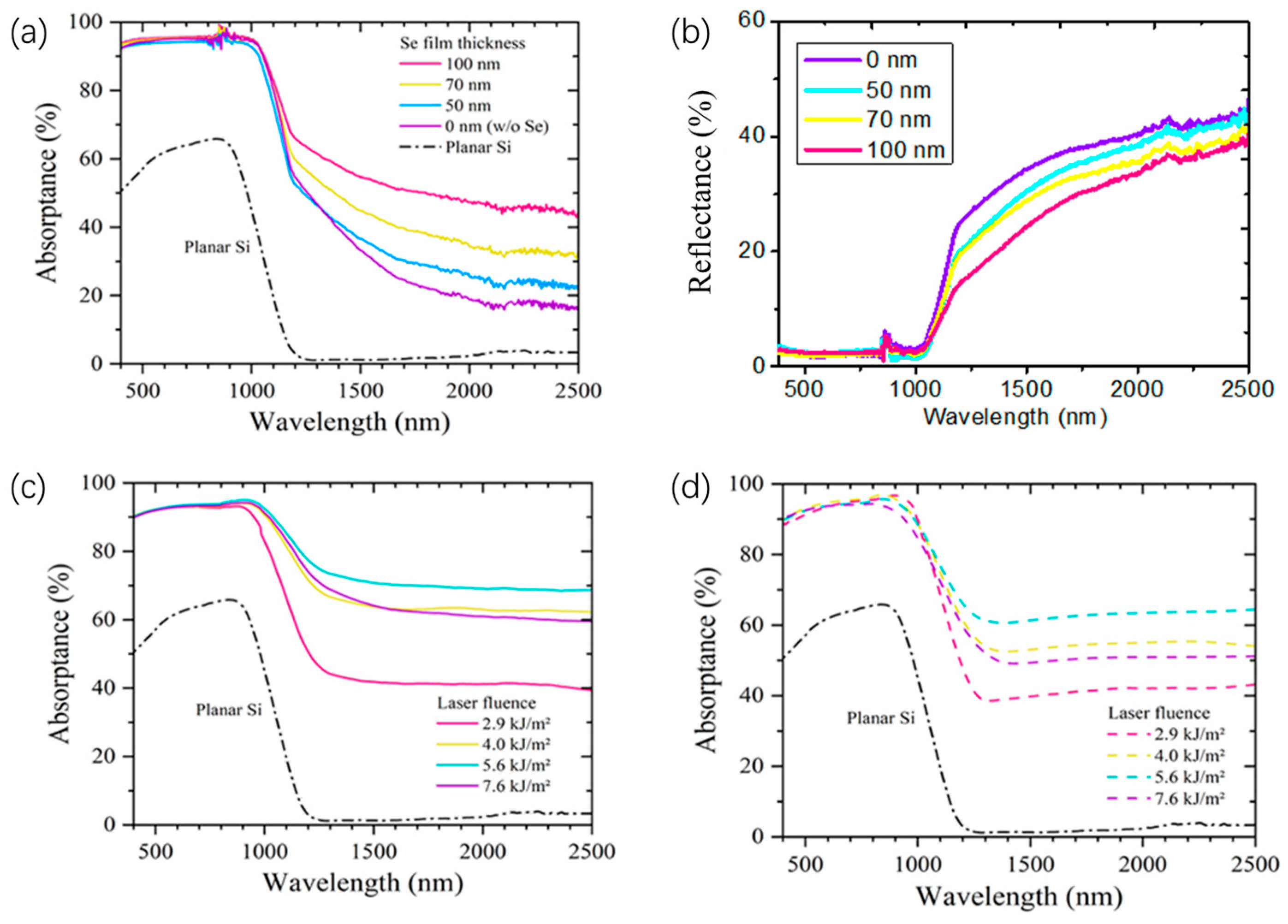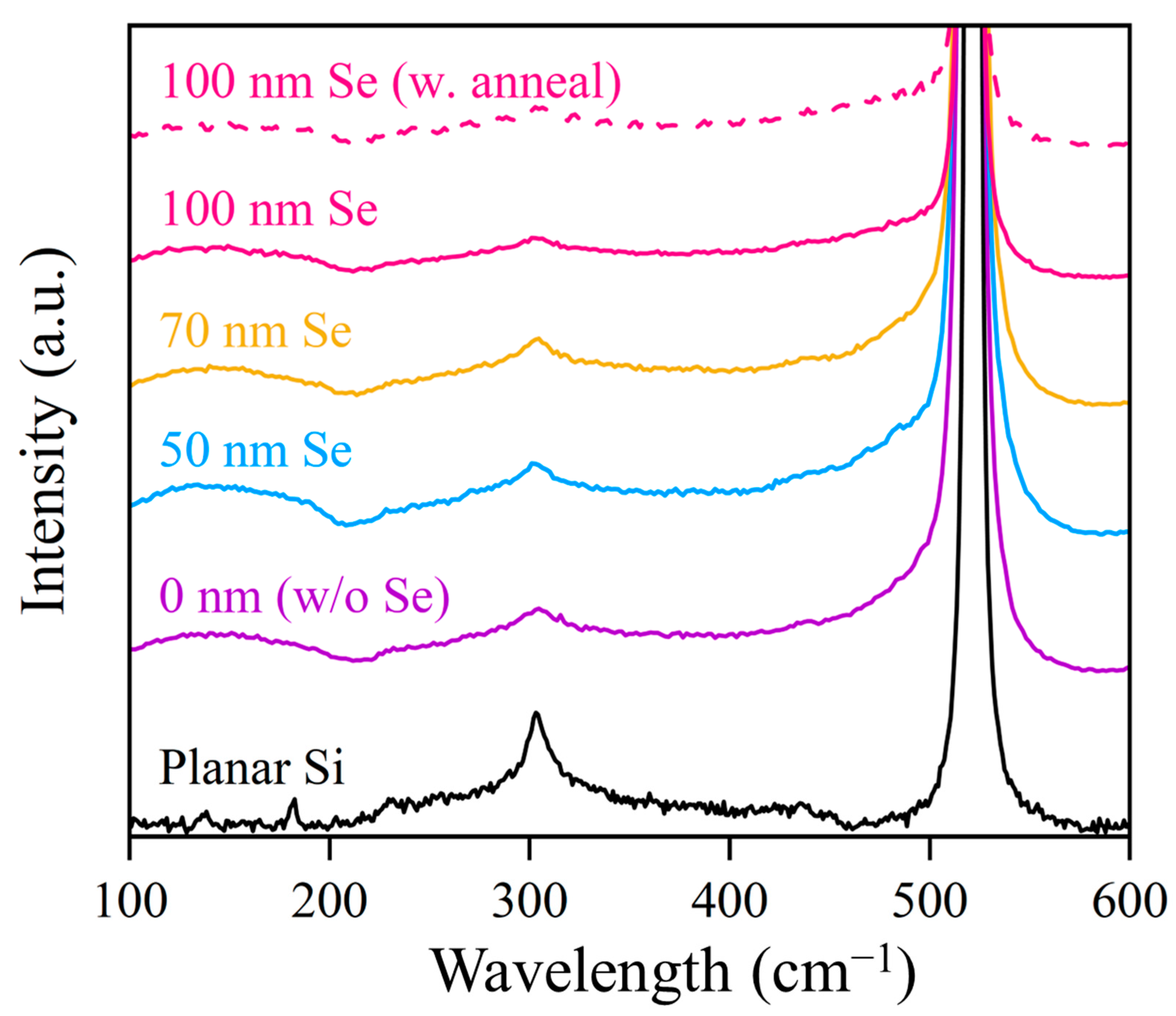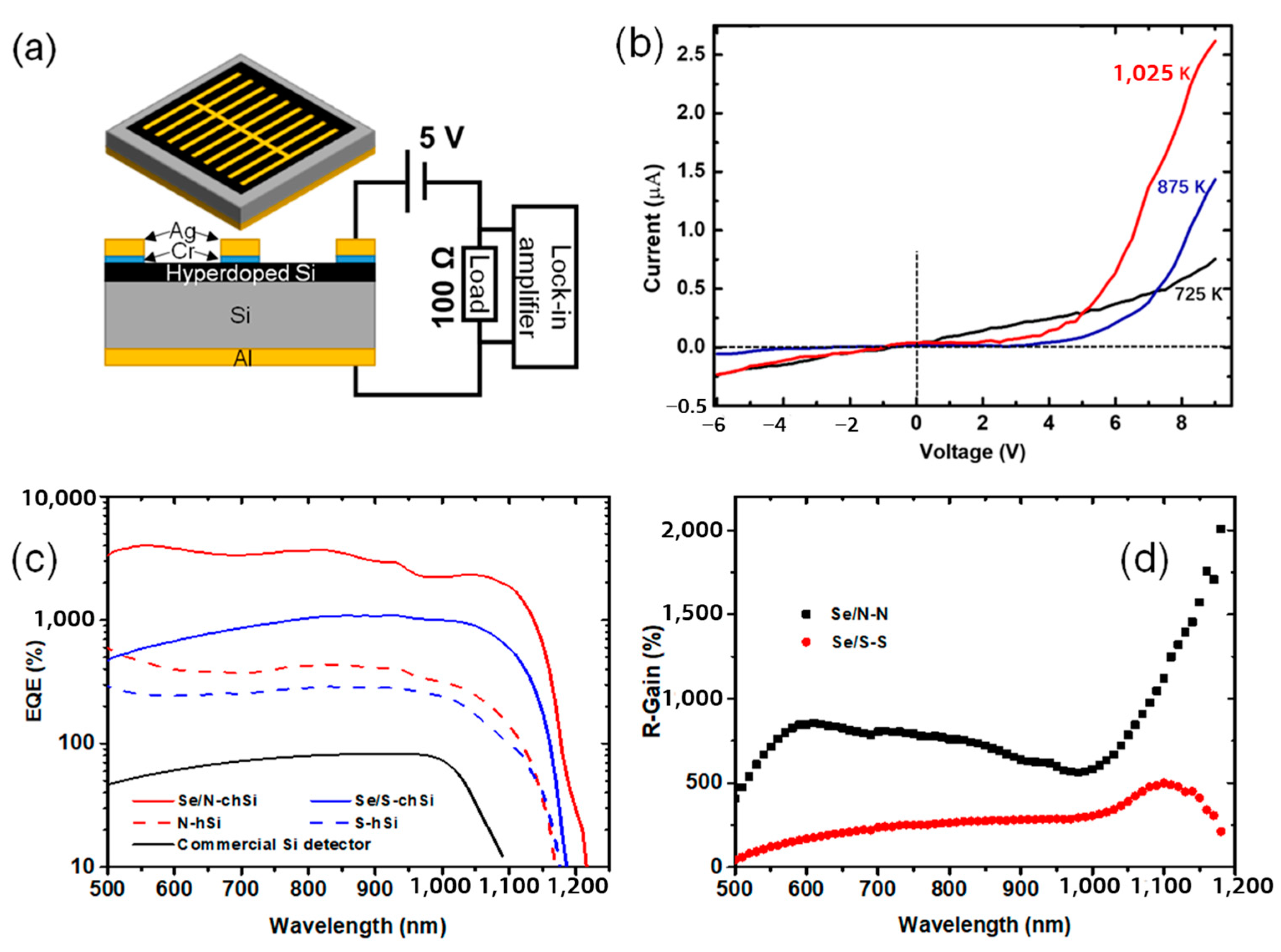Synergic Effect of N and Se Facilitates Photoelectric Performance in Co-Hyperdoped Silicon
Abstract
:1. Introduction
2. Materials and Methods
3. Results
4. Conclusions
Author Contributions
Funding
Data Availability Statement
Conflicts of Interest
References
- Yu, T.; Wang, F.; Xu, Y.; Ma, L.; Pi, X.; Yang, D. Graphene coupled with silicon quantum dots for high-performance bulk-silicon-based Schottky-junction photodetectors. Adv. Mater. 2016, 28, 4912–4919. [Google Scholar] [CrossRef] [PubMed]
- Tian, W.; Sun, H.; Chen, L.; Wangyang, P.; Chen, X.; Xiong, J.; Li, L. Low-dimensional nanomaterial/Si heterostructure-based photodetectors. InfoMat 2019, 1, 140–163. [Google Scholar] [CrossRef]
- Salvato, M.; Scagliotti, M.; De Crescenzi, M.; Boscardin, M.; Attanasio, C.; Avallone, G.; Cirillo, C.; Prosposito, P.; De Matteis, F.; Messi, R.; et al. Time response in carbon nanotube/Si based photodetectors. Sensors Actuators A Phys. 2019, 292, 71–76. [Google Scholar] [CrossRef]
- Alqanoo, A.A.M.; Ahmed, N.M.; Hashim, M.R.; Almessiere, M.A.; Taya, S.A.; Alsadig, A.; Aldaghri, O.A.; Ibnaouf, K.H. Syn-thesis and Deposition of Silver Nanowires on Porous Silicon as an Ultraviolet Light Photodetector. Nanomaterials 2023, 13, 353. [Google Scholar] [CrossRef]
- Crisci, T.; Maccagnani, P.; Moretti, L.; Summonte, C.; Gioffrè, M.; Rizzoli, R.; Casalino, M. The Physics behind the Modulation of Thermionic Current in Photodetectors Based on Graphene Embedded between Amorphous and Crystalline Silicon. Nanomaterials 2023, 13, 872. [Google Scholar] [CrossRef]
- Capista, D.; Lozzi, L.; Pelella, A.; Di Bartolomeo, A.; Giubileo, F.; Passacantando, M. Spatially Resolved Photo-Response of a Carbon Nanotube/Si Photodetector. Nanomaterials 2023, 13, 650. [Google Scholar] [CrossRef] [PubMed]
- Carey, J.E.; Crouch, C.H.; Shen, M.; Mazur, E. Visible and near-infrared responsivity of femtosecond-laser microstructured silicon photodiodes. Opt. Lett. 2005, 30, 1773–1775. [Google Scholar] [CrossRef]
- Fan, Z.; Cui, D.; Zhang, Z.; Zhao, Z.; Chen, H.; Fan, Y.; Li, P.; Zhang, Z.; Xue, C.; Yan, S. Recent Progress of Black Silicon: From Fabrications to Applications. Nanomaterials 2020, 11, 41. [Google Scholar] [CrossRef] [PubMed]
- Lv, J.; Zhang, T.; Zhang, P.; Zhao, Y.; Li, S. Review Application of Nanostructured Black Silicon. Nanoscale Res. Lett. 2018, 13, 110. [Google Scholar] [CrossRef]
- Zhao, L.; Wu, Q.; Zeng, Q.; Yao, J.; Zhang, X.; Xu, J. Sulfur-hyperdoped silicon photodetector with broadband spectral response and high gain at low bias. In CLEO: Science and Innovations; Optica Publishing Group: Washington, DC, USA, 2016; p. JTh2A-37. [Google Scholar]
- Du, L.; Wu, Z.; Li, R.; Tang, F.; Jiang, Y. Near-infrared photoresponse of femtosecond-laser processed Se-doped silicon n^+ − n photodiodes. Opt. Lett. 2016, 41, 5031–5034. [Google Scholar] [CrossRef]
- Dong, X.; Li, N.; Zhu, Z.; Shao, H.; Rong, X.; Liang, C.; Sun, H.; Feng, G.; Zhao, L.; Zhuang, J. A nitrogen-hyperdoped silicon material formed by femtosecond laser irradiation. Appl. Phys. Lett. 2014, 104, 091907. [Google Scholar] [CrossRef]
- Sun, H.; Xiao, J.; Zhu, S.; Hu, Y.; Feng, G.; Zhuang, J.; Zhao, L. Crystallinity and Sub-Band Gap Absorption of Femtosecond-Laser Hyperdoped Silicon Formed in Different N-Containing Gas Mixtures. Materials 2017, 10, 351. [Google Scholar] [CrossRef] [PubMed]
- Sun, H.; Liu, X.-L.; Zhao, L.; Jia, J.; Jiang, C.; Xiao, J.; Chen, Y.; Xu, L.; Duan, Z.; Rao, P.; et al. Mid-long wavelength infrared absorptance of hyperdoped silicon via femtosecond laser microstructuring. Opt. Express 2022, 30, 1808–1817. [Google Scholar] [CrossRef] [PubMed]
- Sun, H.; Liang, C.; Feng, G.; Zhu, Z.; Zhuang, J.; Zhao, L. Improving crystallinity of femtosecond-laser hyperdoped silicon via co-doping with nitrogen. Opt. Mater. Express 2016, 6, 1321–1328. [Google Scholar] [CrossRef]
- Zhu, Z.; Shao, H.; Dong, X.; Li, N.; Ning, B.-Y.; Ning, X.-J.; Zhao, L.; Zhuang, J. Electronic Band Structure and Sub-band-gap Absorption of Nitrogen Hyperdoped Silicon. Sci. Rep. 2015, 5, 10513. [Google Scholar] [CrossRef]
- Crouch, C.; Carey, J.; Shen, M.; Mazur, E.; Génin, F. Infrared absorption by sulfur-doped silicon formed by femtosecond laser irradiation. Appl. Phys. A 2004, 79, 1635–1641. [Google Scholar] [CrossRef]
- Tull, B.R.; Winkler, M.T.; Mazur, E. The role of diffusion in broadband infrared absorption in chalcogen-doped silicon. Appl. Phys. A 2009, 96, 327–334. [Google Scholar] [CrossRef]
- Ma, S.X.; Liu, X.L.; Sun, H.B.; Zhao, Y.; Hu, Y.; Ning, X.J.; Zhao, L.; Zhuang, J. Enhanced responsivity of co-hyperdoped silicon photodetectors fabricated by femtosecond laser irradiation in a mixed SF6/NF3 atmosphere. JOSA B 2020, 37, 730–735. [Google Scholar] [CrossRef]
- Li, S.; Wu, Z.; Du, L.; Shi, Y.; Tang, F.; Li, R.; Jiang, Y. Research on photoelectric characteristics of (S, Se) co-doped silicon fabricated by femtosecond-laser irradiation. J. Mater. Sci. Mater. Electron. 2017, 29, 288–293. [Google Scholar] [CrossRef]
- Shi, Y.; Wu, Z.; Du, L.; Li, S.; Jiang, Y. Effect of the thickness of Si film on Si/Se film doped silicon prepared by femtosecond laser. J. Mater. Sci. Mater. Electron. 2018, 29, 4526–4532. [Google Scholar] [CrossRef]
- Du, L.; Wu, Z.; Su, Y.; Li, R.; Tang, F.; Li, S.; Zhang, T.; Jiang, Y. Se doping of silicon with Si/Se bilayer films prepared by femtosecond-laser irradiation. Mater. Sci. Semicond. Process. 2016, 54, 51–56. [Google Scholar] [CrossRef]
- Hu, S.; Han, P.; Mi, Y.; Xing, Y.; Liang, P.; Fan, Y. Dependence of the optoelectronic properties of selenium-hyperdoped silicon on the annealing temperature. Mater. Sci. Semicond. Process. 2013, 16, 987–991. [Google Scholar] [CrossRef]
- Xu, L.; Zhang, J.; Zhao, H.; Xu, C. Controllable photoinduced scattering and optimized light emission intensity in Nd3+ doped (Pb,La)(Zr,Ti) O3 perovskite ceramics. RSC Adv. 2017, 7, 47165–47169. [Google Scholar] [CrossRef]
- Zhao, J.-H.; Li, X.-B.; Chen, Q.-D.; Chen, Z.-G.; Sun, H.-B. Ultrafast laser-induced black silicon, from micro-nanostructuring, infrared absorption mechanism, to high performance detecting devices. Mater. Today Nano 2020, 11, 100078. [Google Scholar] [CrossRef]
- Tang, F.; Wu, Z.; Du, L.; Li, R.; Jiang, Y. Dependence of the optoelectronic properties of Se-doped silicon on the thickness of dopant film. J. Mater. Sci. Mater. Electron. 2016, 28, 4083–4087. [Google Scholar] [CrossRef]
- Wu, X.; Li, W.; Chen, Q.; Xu, C.; Wang, J.; Wu, L.; Liu, G.; Wang, W.; Li, T.; Chen, P.; et al. Mechanism of Photocurrent Deg-radation and Contactless Healing in p-Type Mg-Doped Gallium Nitride Thin Films. Nanomaterials 2022, 12, 899. [Google Scholar] [CrossRef]
- Wang, X.-Y.; Huang, Y.-G.; Liu, D.-W.; Zhu, X.-N.; Zhu, H.-L. High Response in a Tellurium-Supersaturated Silicon Photodiode. Chin. Phys. Lett. 2013, 30, 036101. [Google Scholar] [CrossRef]
- Sheehy, M.A.; Tull, B.R.; Friend, C.M.; Mazur, E. Chalcogen doping of silicon via intense femtosecond-laser irradiation. Mater. Sci. Eng. B 2006, 137, 289–294. [Google Scholar] [CrossRef]
- Ertekin, E.; Winkler, M.T.; Recht, D.; Said, A.J.; Aziz, M.J.; Buonassisi, T.; Grossman, J.C. Insulator-to-metal transition in se-lenium-hyperdoped silicon: Observation and origin. Phys. Rev. Lett. 2012, 108, 026401. [Google Scholar] [CrossRef]
- Dong, X.; Wang, Y.; Song, X.; Yang, F. First-principles studies of a photovoltaic material based on silicon heavily codoped with sulfur and nitrogen. Appl. Phys. Express 2018, 11, 031303. [Google Scholar] [CrossRef]
- Dong, X.; Wang, Y.; Song, X. Engineering intermediate-band photovoltaic material by heavily co-doping selenium and nitrogen in silicon. Appl. Phys. Express 2017, 11, 011303. [Google Scholar] [CrossRef]




Disclaimer/Publisher’s Note: The statements, opinions and data contained in all publications are solely those of the individual author(s) and contributor(s) and not of MDPI and/or the editor(s). MDPI and/or the editor(s) disclaim responsibility for any injury to people or property resulting from any ideas, methods, instructions or products referred to in the content. |
© 2024 by the authors. Licensee MDPI, Basel, Switzerland. This article is an open access article distributed under the terms and conditions of the Creative Commons Attribution (CC BY) license (https://creativecommons.org/licenses/by/4.0/).
Share and Cite
Sun, H.; Liu, X.; Xu, C.; Xu, L.; Chen, Y.; Yang, H.; Yang, X.; Rao, P.; Sun, S.; Zhao, L. Synergic Effect of N and Se Facilitates Photoelectric Performance in Co-Hyperdoped Silicon. Nanomaterials 2024, 14, 1591. https://doi.org/10.3390/nano14191591
Sun H, Liu X, Xu C, Xu L, Chen Y, Yang H, Yang X, Rao P, Sun S, Zhao L. Synergic Effect of N and Se Facilitates Photoelectric Performance in Co-Hyperdoped Silicon. Nanomaterials. 2024; 14(19):1591. https://doi.org/10.3390/nano14191591
Chicago/Turabian StyleSun, Haibin, Xiaolong Liu, Caixia Xu, Long Xu, Yuwei Chen, Haima Yang, Xing Yang, Peng Rao, Shengli Sun, and Li Zhao. 2024. "Synergic Effect of N and Se Facilitates Photoelectric Performance in Co-Hyperdoped Silicon" Nanomaterials 14, no. 19: 1591. https://doi.org/10.3390/nano14191591
APA StyleSun, H., Liu, X., Xu, C., Xu, L., Chen, Y., Yang, H., Yang, X., Rao, P., Sun, S., & Zhao, L. (2024). Synergic Effect of N and Se Facilitates Photoelectric Performance in Co-Hyperdoped Silicon. Nanomaterials, 14(19), 1591. https://doi.org/10.3390/nano14191591







